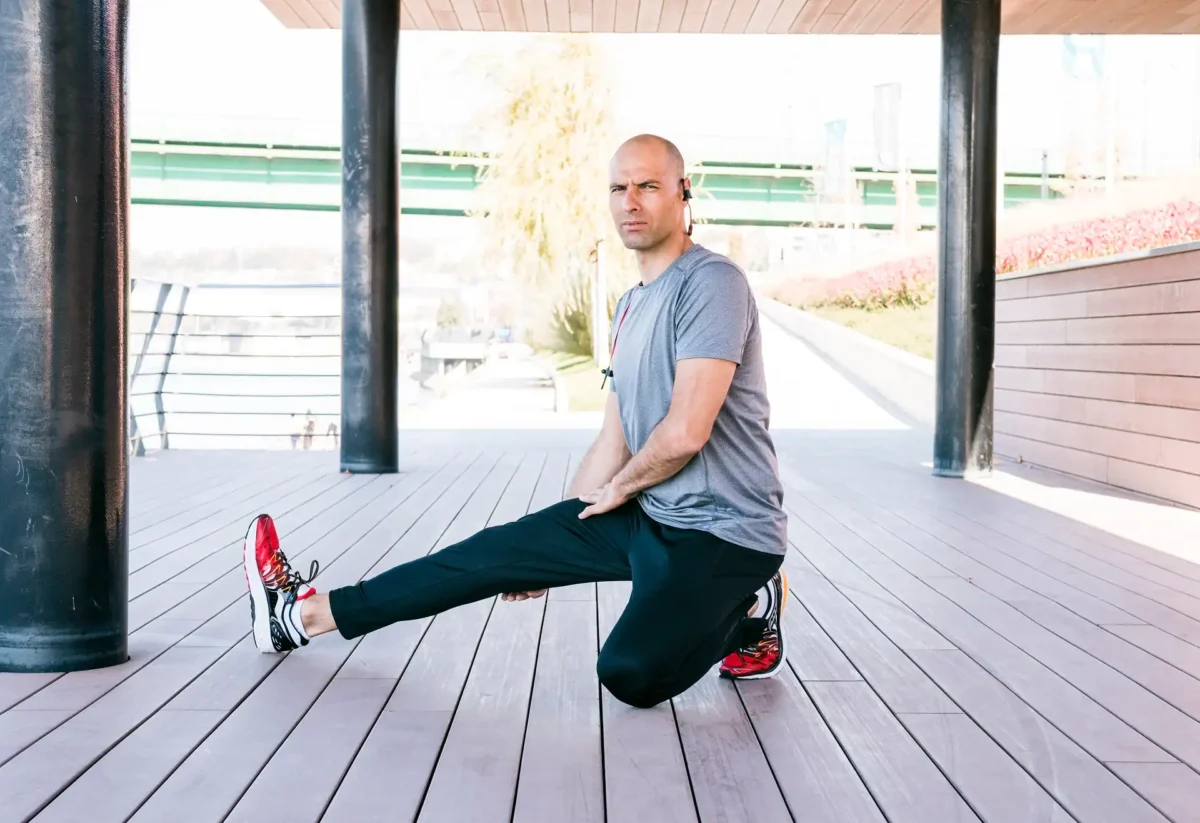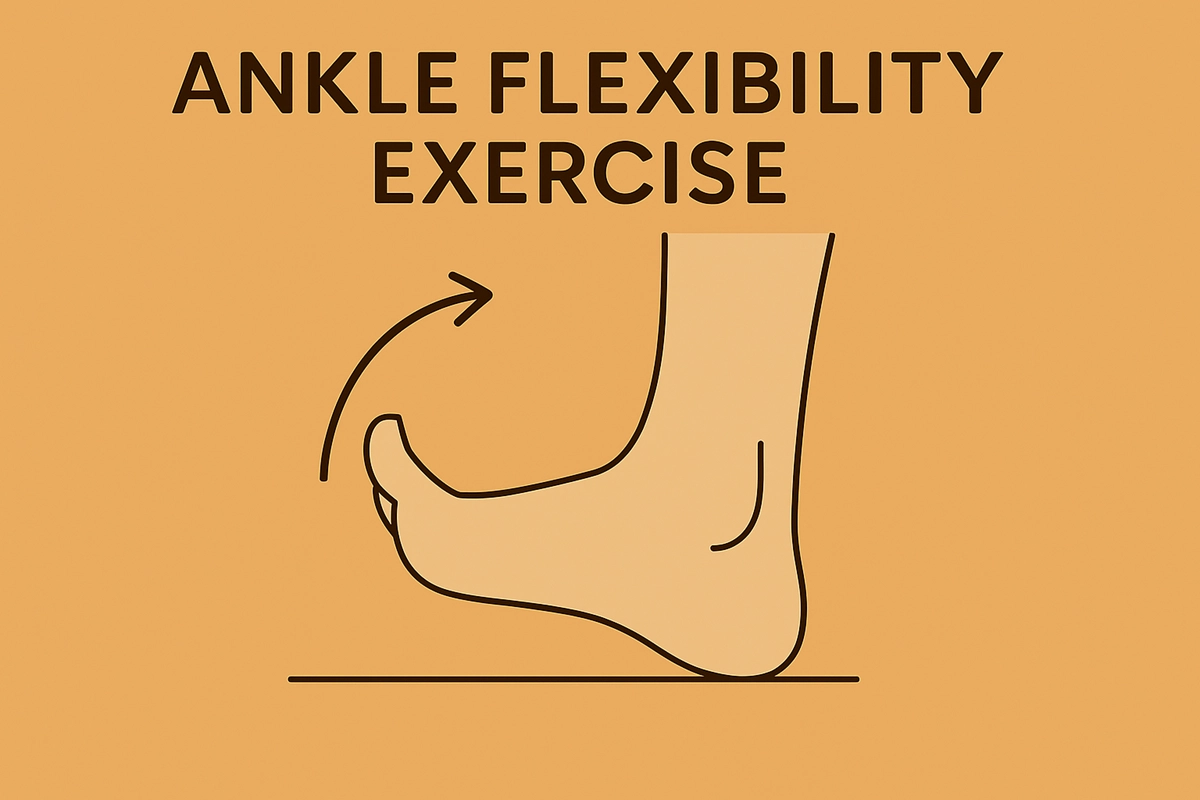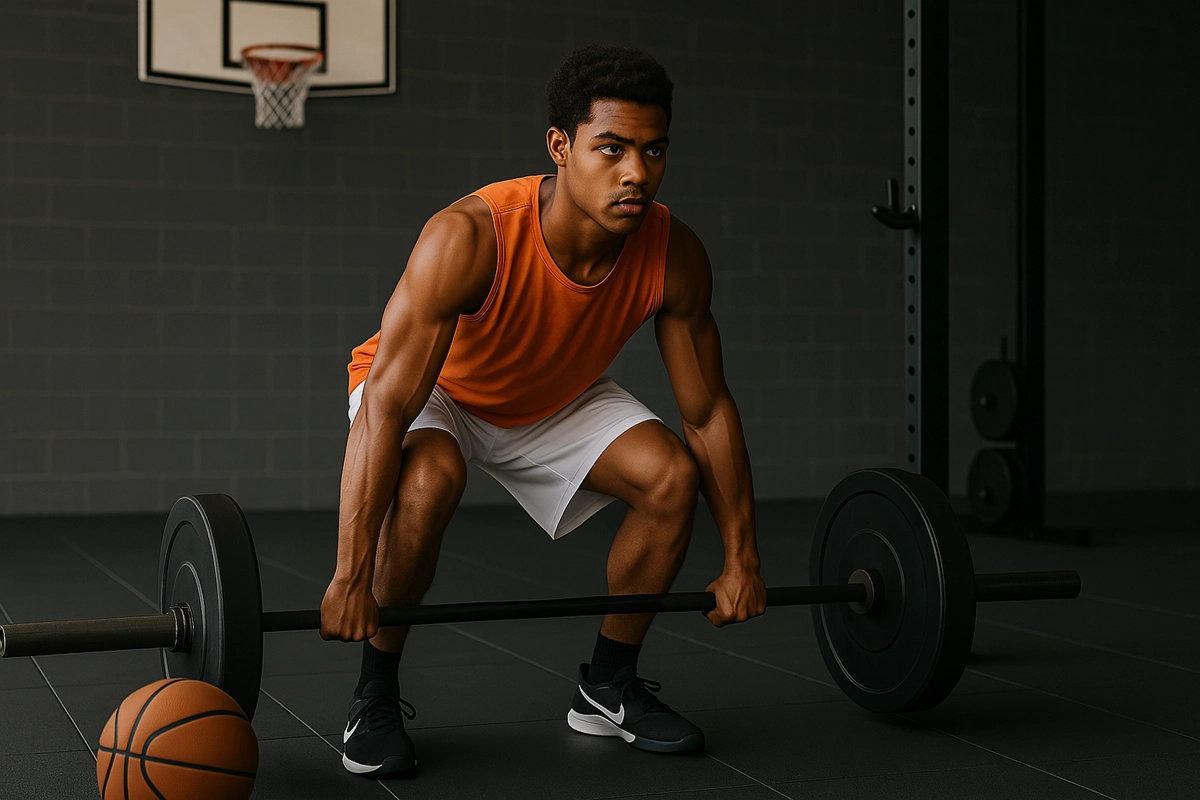Arnold Schwarzenegger once said that building impressive lats was like “spreading your wings to create the perfect V-taper.” You’ll discover that developing wider, thicker lats isn’t just about basic pulldowns – it requires strategic exercise selection and proper form.
From classic moves like deadlifts to advanced techniques that Arnold himself used, these 15 proven exercises will transform your back development and help you achieve that coveted cobra-like appearance.
What Are Your Lats?
Your latissimus dorsi muscles, commonly referred to as “lats,” serve as powerful engines for upper body movement, creating that sought-after V-taper physique.
These triangle-shaped muscles span your back’s width, and they’re vital for exercises like the straight-arm pulldown, face pulldown, and Yates row.
Understanding your lats is significant before diving into movements like dumbbell dead rows or resistance band work.
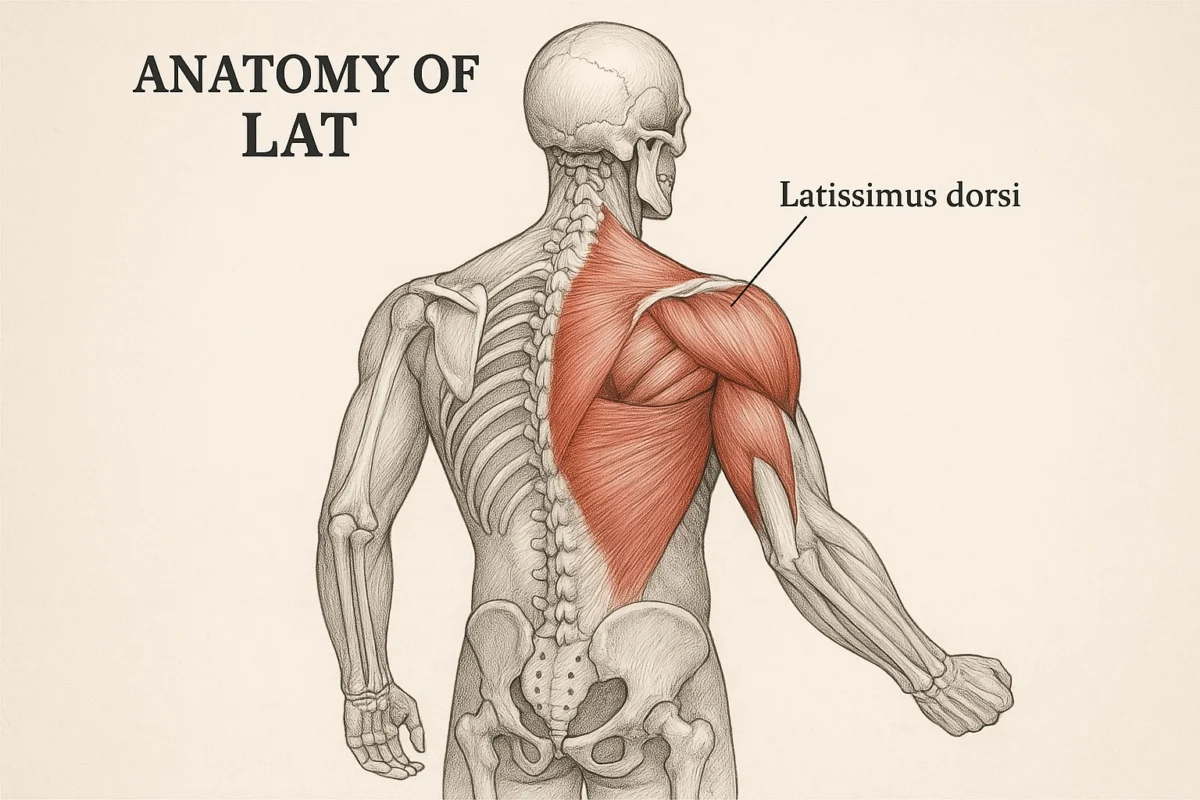
They’re the largest muscles in your upper body, extending from your shoulder blade down to your waist, creating that distinctive wide-backed appearance that Arnold made famous during his Mr. Olympia days.
Think of your lats as wings that, when appropriately developed, give you that powerful, athletic look.
They’re not just for show – they’re fundamental to your overall upper body strength and functionality.
How to Train Your Lats
Proper lat training requires three key movement patterns: vertical pulls, horizontal rows, and straight-arm exercises that target the full range of motion.
When performing lat exercises like the Kroc row or seal rows, you’ll get the best results using a traditional grip with your arms by your sides.
For optimal muscle recruitment during exercises like the Hammer Strength row, maintain a medium grip width. Going too broad shifts the focus to your rear delts and middle traps instead of your lats.
Use the Hevy app to track your progress and confirm you’re maintaining proper form.
How to Incorporate Lat Exercises Into Workouts
When planning your leg training, strategically incorporating exercises across different workouts will maximize growth potential and prevent overtraining.
You’ll want to integrate these movements into your pull days or dedicated back sessions, performing at least two to three exercises weekly.
For optimal results, utilise tools like the Fitbod app to track your progress and the TRX suspension system for bodyweight variations.
Endurance athletes should focus on plank and pull movements to build functional strength.
Don’t forget your lifting belts for heavy compound exercises.
Schedule regular recovery weeks to prevent burnout and maintain steady progress.
Whether you’re following a push/pull/legs split or a traditional body part split, consistency is key.
The Benefits of Lat Exercises
Building powerful lats delivers impressive benefits that extend far beyond just looking good in the gym. Your rotator cuffs and cervical spine disks benefit from the added stability, while exercises like the meadows row strengthen your biceps brachii and improve overall pulling power.
You’ll notice enhanced performance across various exercises, particularly in your deadlifts, where lifting straps can help you maximize your lat engagement.
As Kevin Purvis, a renowned strength coach, often emphasizes, well-developed lats are essential for achieving that coveted V-taper physique. However, it’s not just about aesthetics – strong lats contribute significantly to better posture, mainly if you’ve been focusing too heavily on chest exercises.
They help balance your physique and prevent the rounded-shoulder look that comes from overdeveloping your anterior chain muscles.
The Best Lat Exercises
When it comes to building a wider, thicker back, specific lat exercises have proven to be effective in bodybuilding. Your latissimus dorsi muscles respond best to heavy compound movements that create ideal muscle hypertrophy.
Start with the classic lat pulldown, which Arnold himself credited for his impressive V-taper. You’ll want to include both close and wide-grip variations.
Next, master the barbell row—a foundational movement that builds significant back thickness when performed with strict form.
For unilateral development, the single-arm dumbbell row is unmatched. This exercise allows you to focus on each side independently while maintaining stability through your core.
Remember Arnold’s advice: “The mind is the limit. As long as the mind can envision doing something, you can do it.”
1. Deadlifts
Although many lifters view the deadlift primarily as a leg exercise, it’s one of the most powerful lat builders in your arsenal. Your lat muscles work overtime to stabilize the weight throughout the movement, leading to significant muscle growth through progressive overload.
To maximize lat activation during deadlifts:
- Position yourself close to the bar, nearly touching your shins
- Grip the bar slightly wider than shoulder-width
- Keep your spine tall and chest up
- Push your hips back before bending your knees
- Pull the weight by standing tall, engaging your back muscles
- Control the descent
While your hamstrings and glutes are working hard, your lats are constantly under tension as they help control and stabilize the heavy weight.
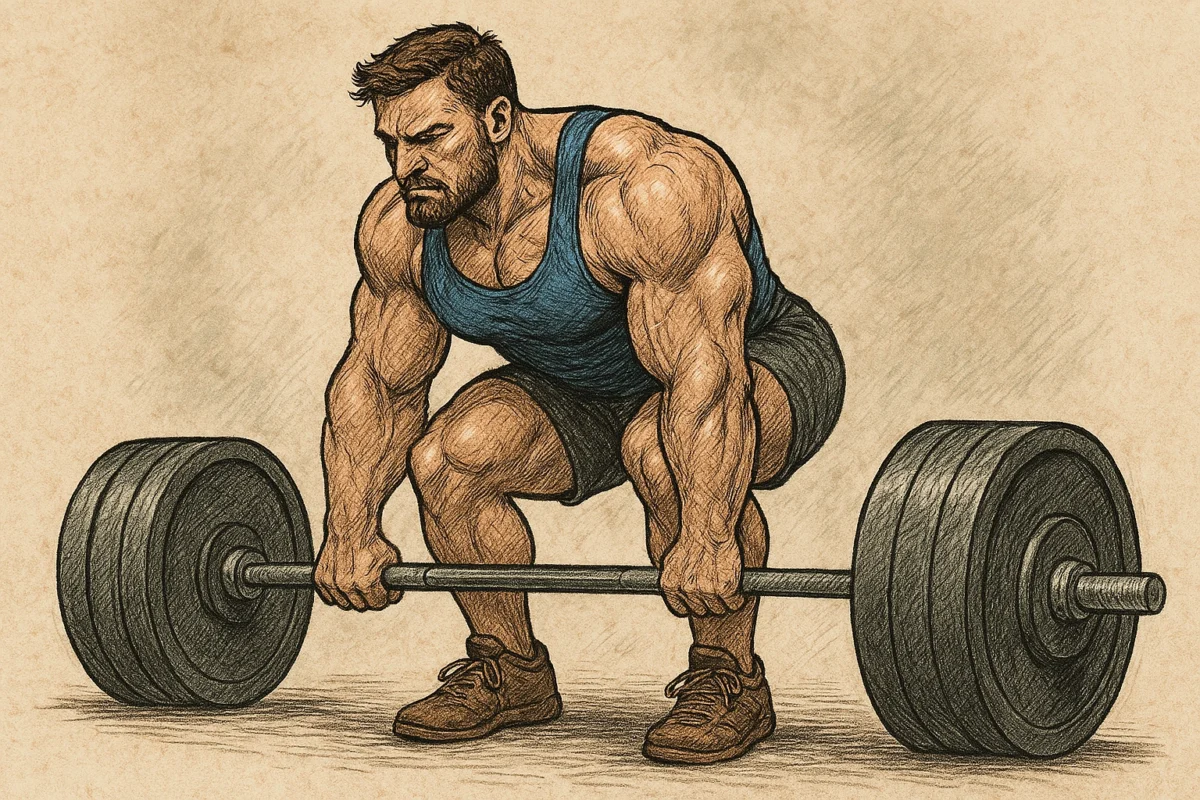
This compound movement builds serious back thickness when performed consistently with proper form.
Sets and Reps: 3 to 4 sets of 6 to 8 reps
2. Barbell Row
The barbell row stands as another powerhouse movement for building massive lats, working perfectly alongside deadlifts in your back-building arsenal.
This strength training exercise targets multiple muscles throughout your posterior chain, delivering impressive muscular hypertrophy when performed correctly.
To execute the perfect barbell row, hinge at your hips until your torso is at a 45-degree angle, gripping the bar with your hands shoulder-width apart.
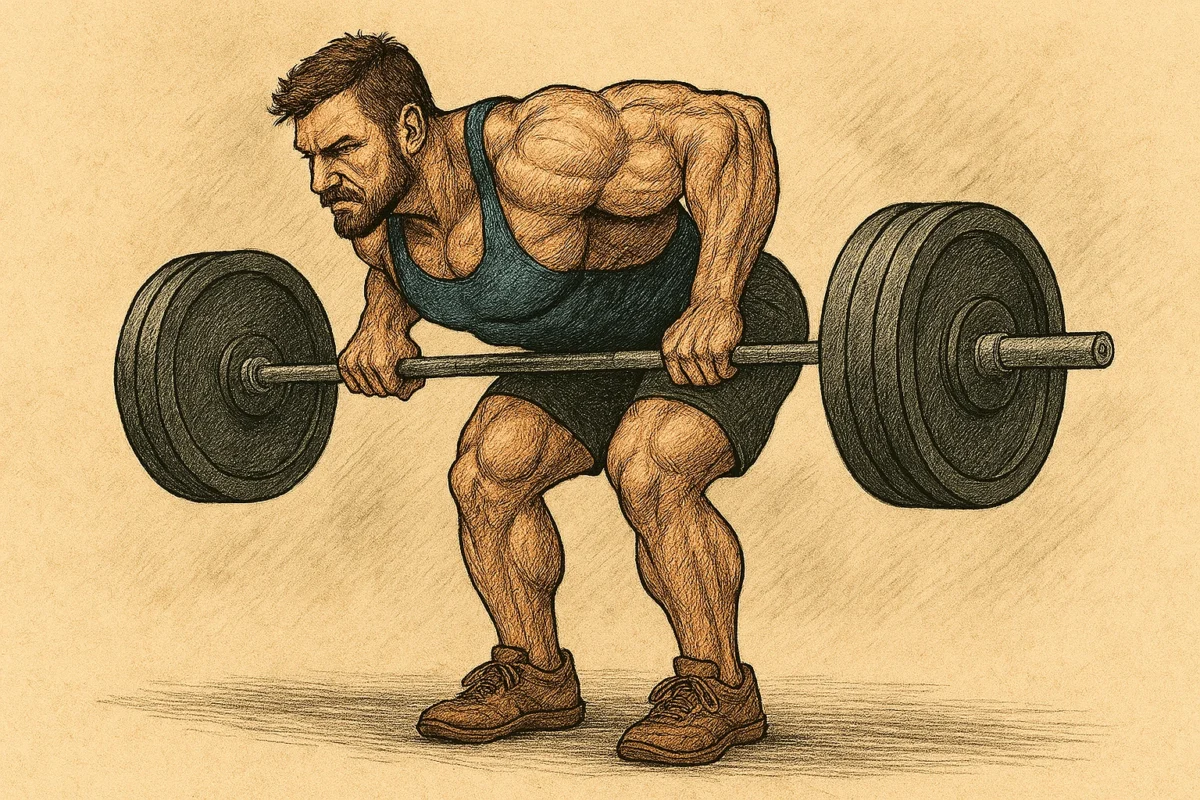
Keep your core tight and eyes down, then pull the weight to your lower chest while squeezing your lat muscles.
For optimal results, use moderate to heavy weights and aim for 10 reps or fewer to protect your lower back from fatigue.
You can program this as either a primary movement or an accessory exercise, making it incredibly versatile for developing the upper back.
Sets and Reps: 3 sets of 8 to 10 reps
3. Dumbbell Row
Mastering dumbbell rows can transform your back development, making them a cornerstone exercise in any serious strength training program. This unilateral movement maximizes the engagement of the lat muscle fibers while developing balanced upper body strength.
To perform the exercise, grab a dumbbell in one hand and hinge forward until your torso is nearly parallel with the ground. Place your free hand on a bench for support, ensuring your core stays tight. Pull the weight toward your rib cage, focusing on muscular recruitment in your back muscles.
For ideal lat training results, emphasize the stretch at the bottom of each rep. Keep your torso steady throughout the movement – any swaying reduces the exercise’s effectiveness.
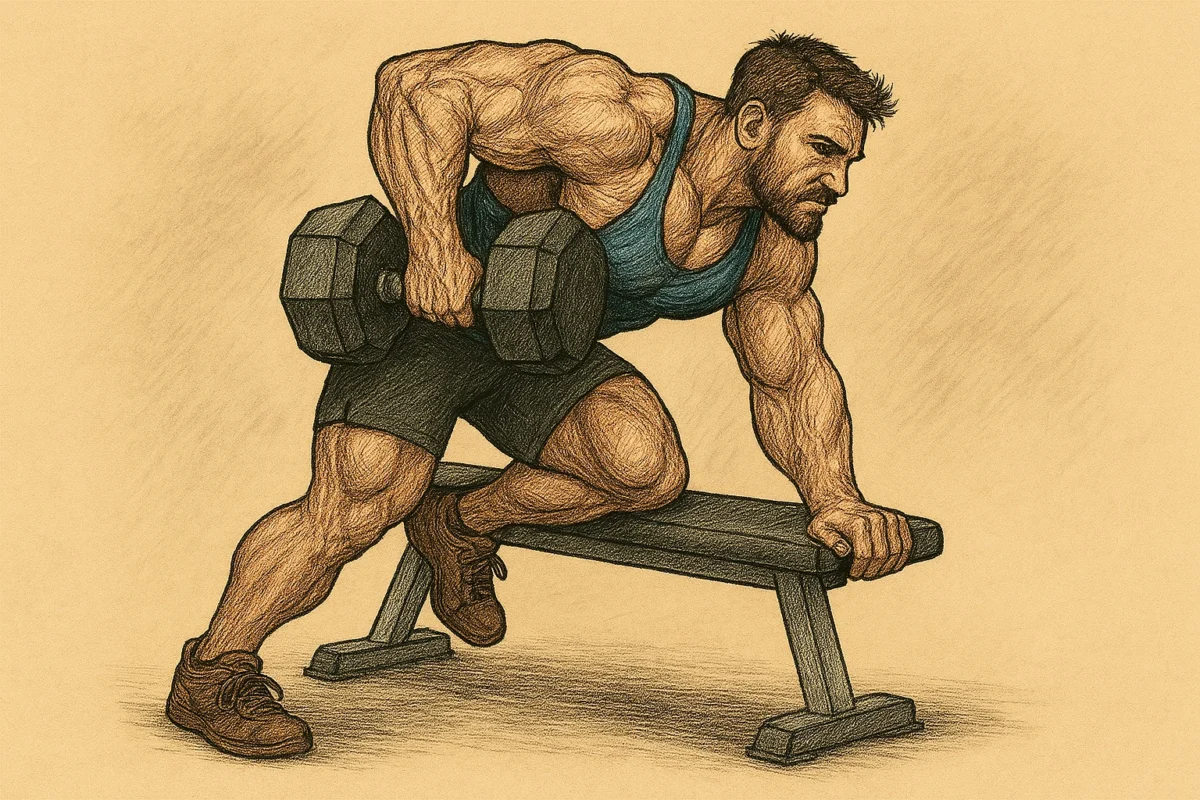
Start with lighter weights to perfect your form before progressing to heavier loads that challenge your muscular endurance.
Sets and Reps: 3 sets of 8 to 12 reps
4. Incline Dumbbell Row
Elevating your dumbbell row game starts with the incline variation, a movement that forces strict form while targeting those hard-to-hit lower latissimus dorsi fibres. By positioning your chest on a 45-degree bench, you’ll eliminate the body English that often creeps into standard dumbbell rows.
Stand with your chest against the bench, maintaining an athletic stance with your feet firmly planted. Your core muscles must remain engaged throughout the movement.
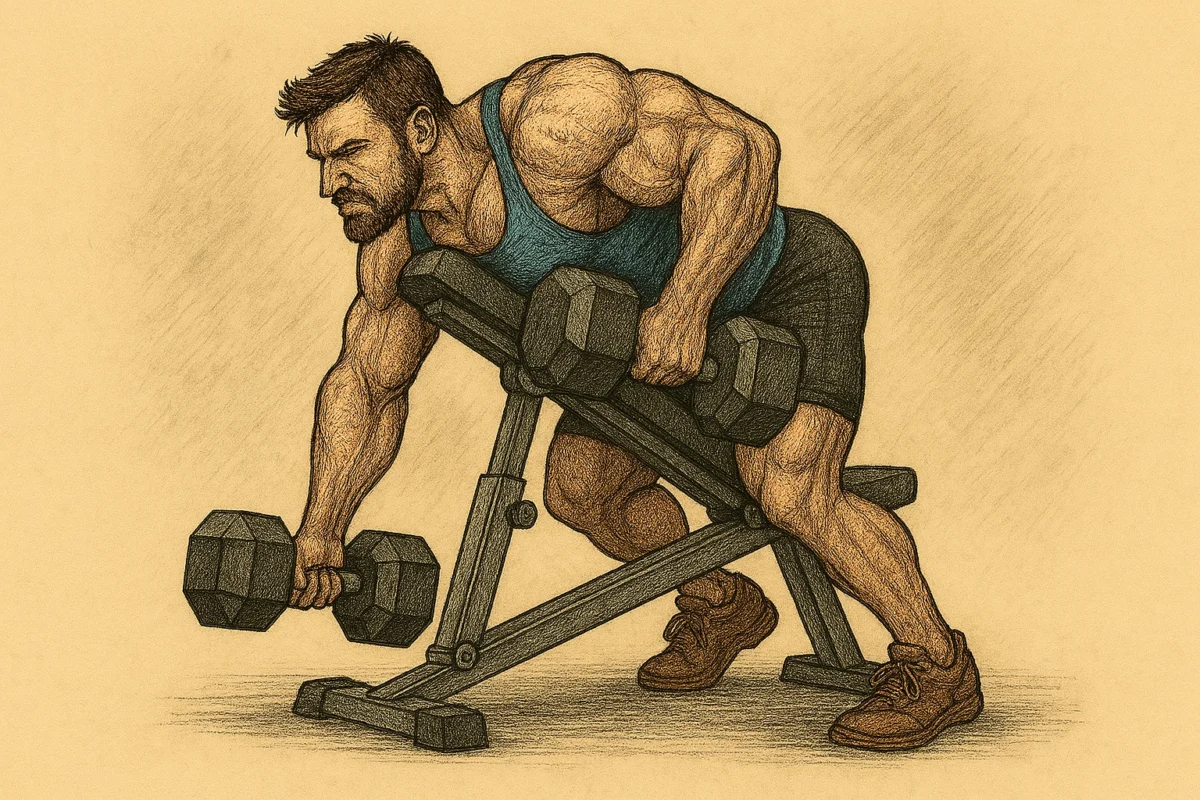
As you grip the dumbbells, keep your neck in a neutral position and your eyes forward. Pull the weight toward your hips, focusing on engaging your latissimus dorsi muscles with each rep. Various grip variations can help target different areas of your lats, but start with a neutral grip to master proper form.
Control the negative portion of each rep for maximum muscle engagement.
Sets and Reps: 3 sets of 8 to 10 reps
5. Seated Cable Row
Moving from free weights to cables, seated cable rows put you in the ideal position to build impressive back width and thickness. This foundational exercise enhances scapular stability while maximizing lat strength and muscle activation levels.
To perform the seated cable row correctly:
- Position yourself on the lat pull-down machine with your feet placed wider than shoulder-width apart.
- Grasp the handle and lean slightly forward, rounding your upper back.
- Pull your shoulder blades apart to create maximum stretch in your lats.
- Row the handle toward your belly button while pulling your shoulder blades down and back.
- Maintain a straight spine throughout the movement.
Focus on controlled movements and proper form to guarantee peak muscle engagement.
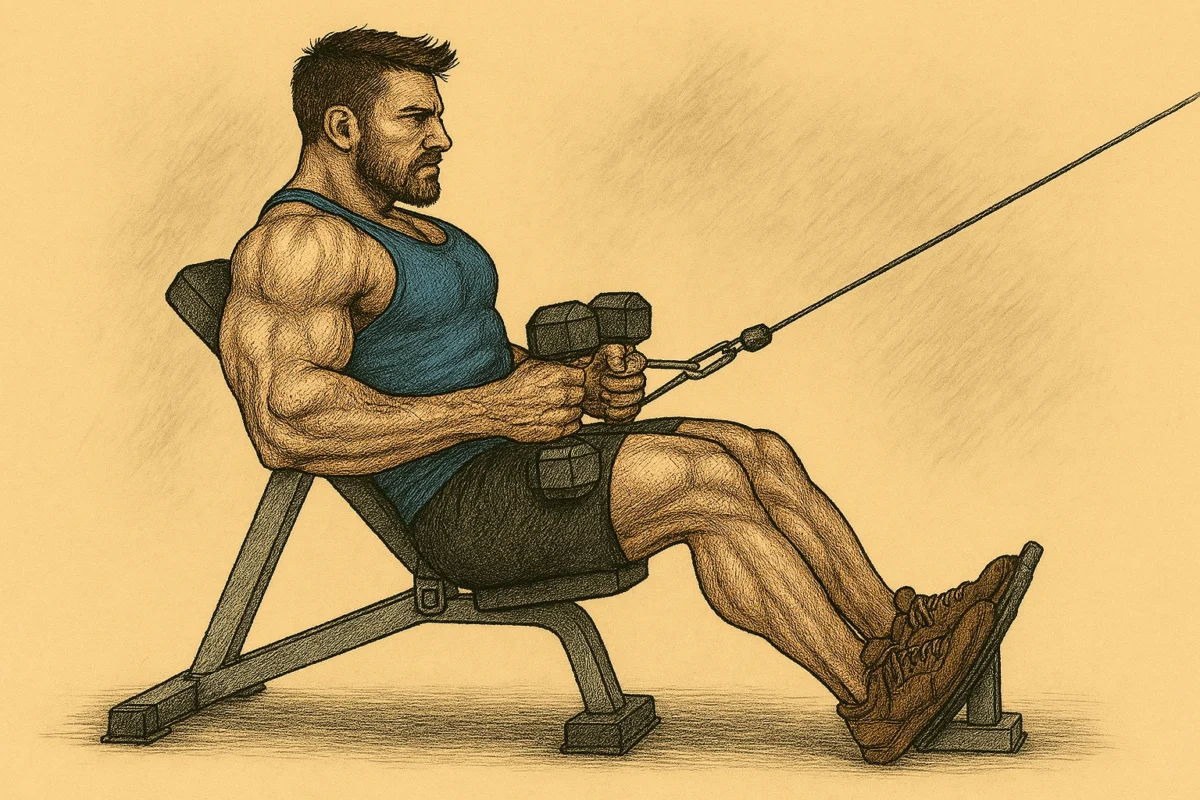
You’ll notice improved back development and enhanced posture as you progress with this exercise.
Sets and Reps: 3 to 4 sets of 10 to 15 reps
6. Reeves Incline Row
Transform your back development with the Reeves Incline Row, an advanced variation that challenges your muscles from a unique angle. This horizontal pulling movement targets your latissimus fibers through a wider grip position, creating new stimulus for muscle growth.
Here’s how to perform the exercise:
- Position your chest on an incline bench with a loaded EZ bar or short barbell underneath.
- Grab the bar by the weight plates using a wide grip.
- Lift the bar from the ground while keeping your shoulder blades tight.
- Pull the bar up until it touches the bench.
- Lower with control to the starting position.
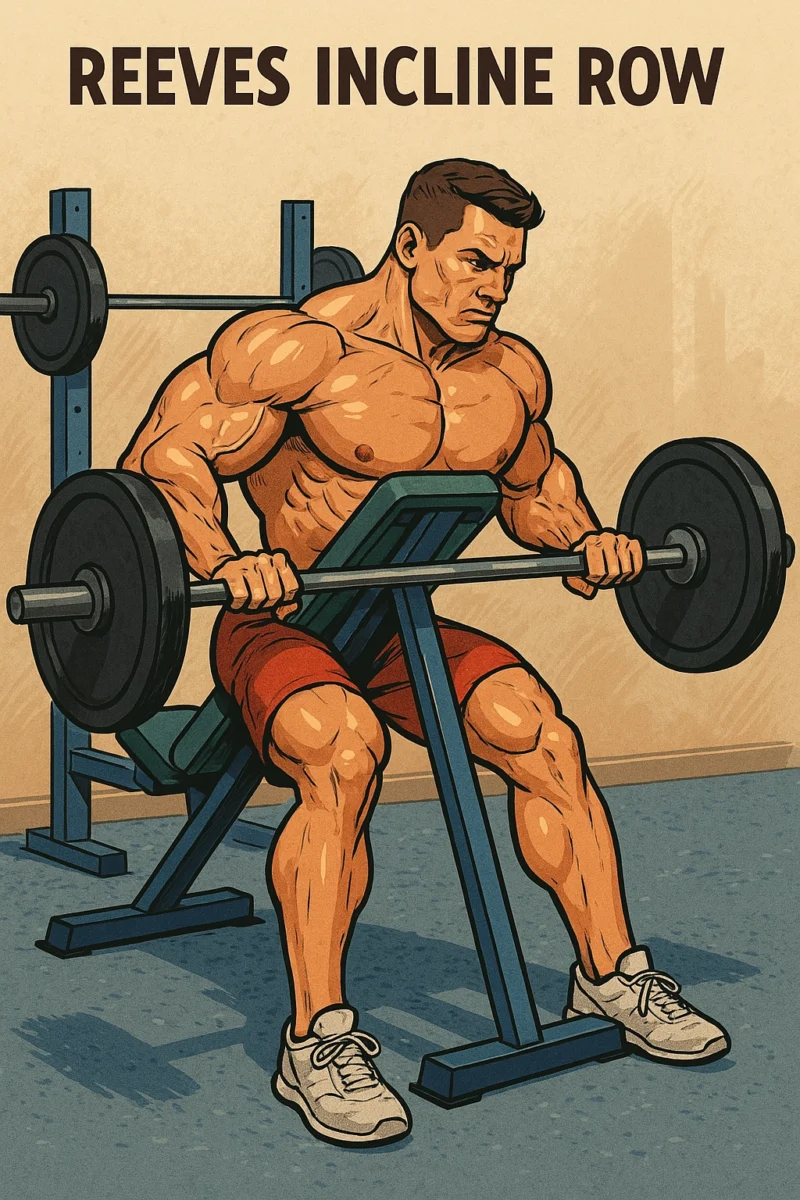
This exercise equipment setup allows for a greater range of motion compared to traditional rows.
You’ll feel increased engagement throughout your entire back as you master this movement pattern.
Sets and Reps: 3 to 4 sets of 8 to 10 reps
7. Gorilla Row
The Gorilla Row stands out as one of the most primal and effective ways to build serious back thickness and strength.
Unlike traditional bent-over rows, this variation helps protect you from shoulder impingement and rotator cuff injuries by letting you work from a dead stop.
Here’s how to master it:
- Take a wider stance than your standard bent-over row position
- Keep your core tight and hips below shoulder height
- Grip both weights firmly on the ground
- Row one weight up while pressing the other into the floor
- Alternate sides with controlled movement
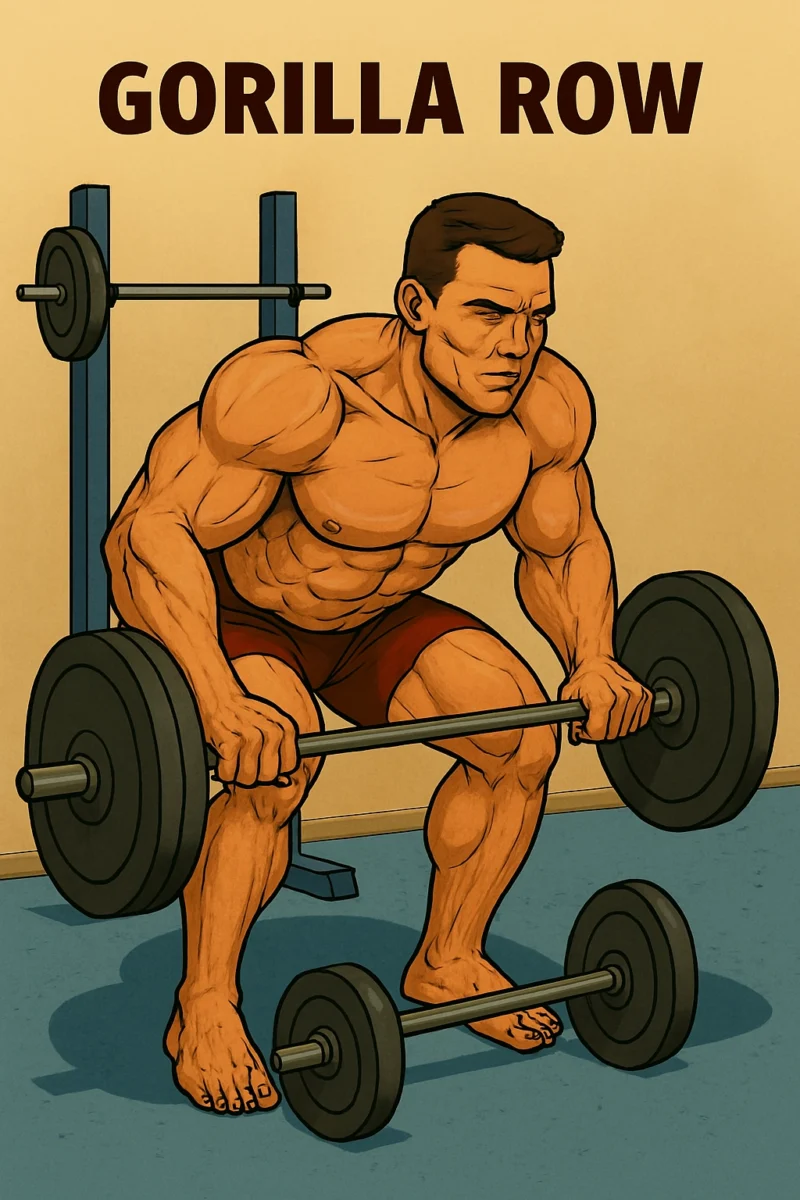
This exercise builds the core strength you’ll need for other back builders, such as weighted chin-ups.
The dead-stop element guarantees perfect form on each rep, while the alternating pattern prevents momentum from taking over your gains.
Sets and Reps: 3 to 4 sets of 8 to 10 reps
8. Pullups and Chinups
Mastering pull-ups and chin-ups will transform your back development like no other exercise can.
These vertical pulling movements target your lats more effectively than any lat pulldown machine, helping you build that coveted v-taper torso.
You’ll need proper form to maximize muscle fiber recruitment. Start by hanging from a bar with either an overhand grip (for pull-ups) or an underhand grip (for chin-ups), with your hands positioned shoulder-width apart.
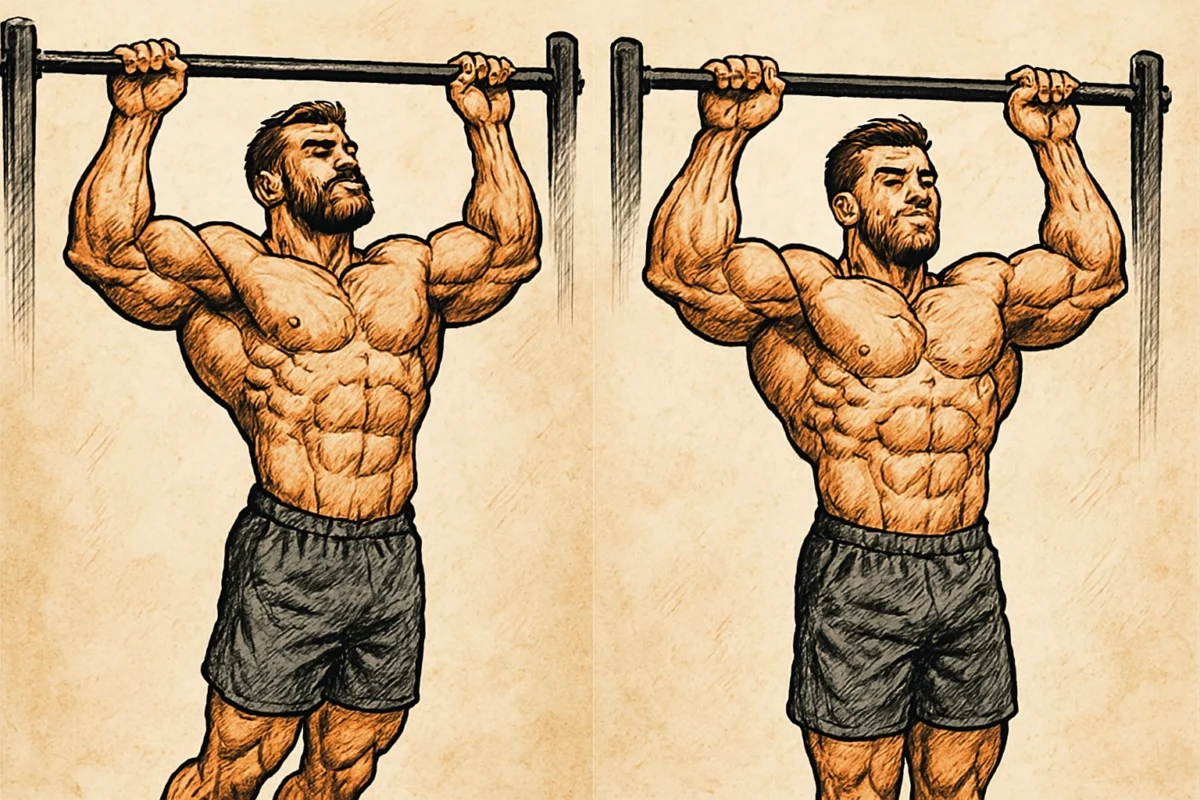
Keep your core engaged as you pull your chest toward the bar, focusing on squeezing your lats throughout the movement. Avoid the CrossFit-style “kip” – it’s just momentum, not muscle.
Aim for 3 sets of 10 reps with controlled negatives. If you can’t complete full reps yet, use assisted variations until you build the necessary strength.
Sets and Reps: 4 sets of 6 to 8 reps
9. Lat Pulldowns
When you can’t access a pull-up bar or need to build foundational strength, lat pulldowns become your go-to exercise for developing a wider back.
You’ll find this cable pulley movement in every serious exercise library, and it’s perfect for tracking your performance gains.
Sit at the station with a grip slightly wider than your shoulders, though you can switch to a supinated grip for variety.
Keep your torso at a 60-degree angle, then pull the bar toward your chest while squeezing your shoulder blades.
Control the weight as you return to the starting position.
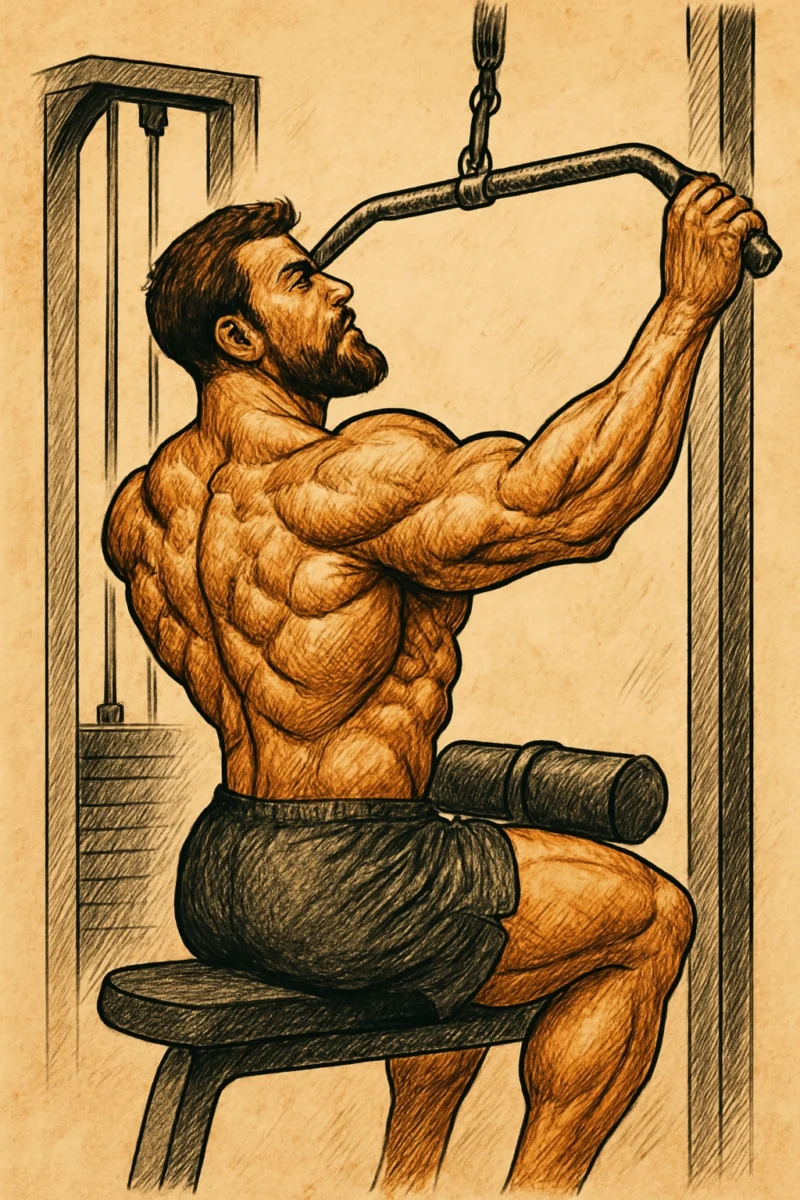
You can program lat pulldowns as a superset with pushing movements or use them to train until muscular failure.
They’re also excellent for activating your lats before heavier exercises, just as Arnold used them to warm up his legendary back workouts.
Set and Reps: 3 to 4 sets of 8 to 12 reps
10. Close-Grip Lat Pulldown
Switching to a close-grip position transforms this classic lat exercise into a powerful mass-builder for your back. By narrowing your grip on the cable machine, you’ll create a greater range of motion while protecting your shoulder joint from unnecessary stress.
Here’s how to nail the close-grip pulldown for maximum lat sweeps:
- Position yourself at the machine and grasp the V-handle or bar with a neutral or underhand grip.
- Set your feet firmly, brace your core, and lean back slightly.
- Drive your elbows down and back, pulling the handle to your upper chest.
- Control the weight as you return to the starting position.
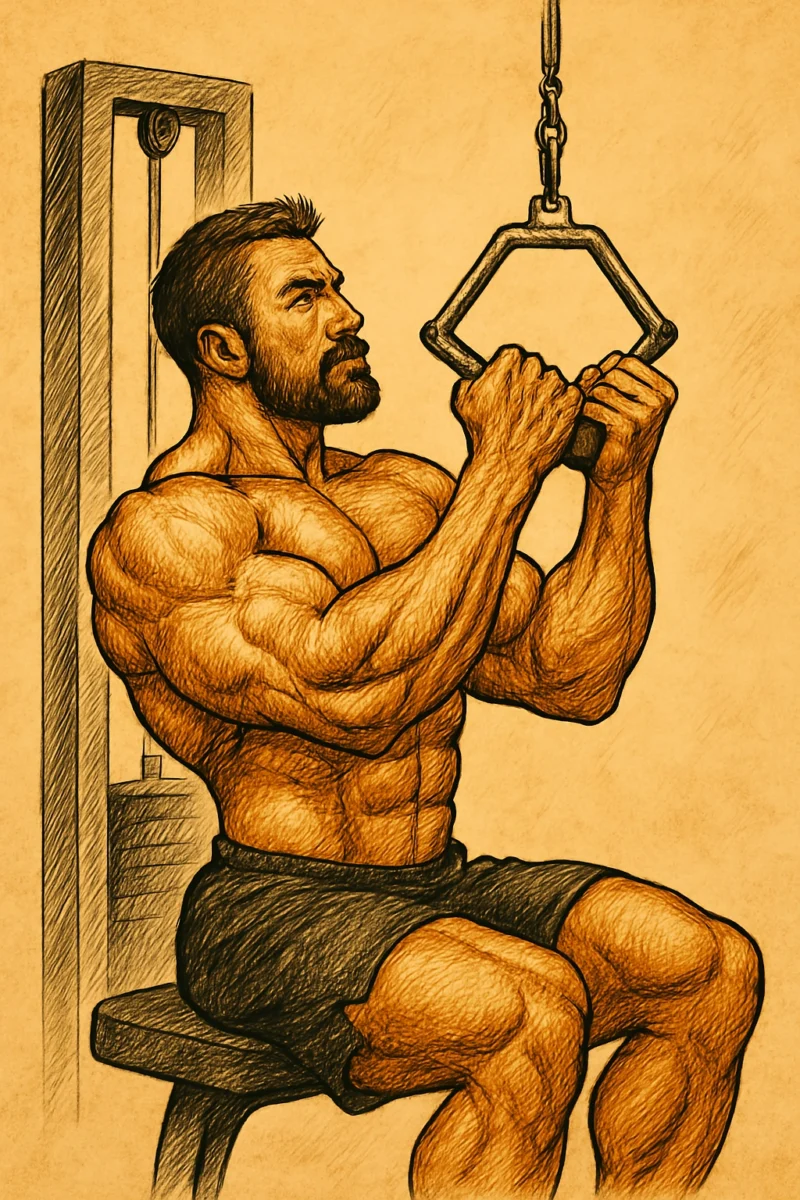
This variation complements your standard rowing movements and helps prevent muscle imbalances.
You’ll notice more depth in your back development, especially in the lower lats.
Sets and Reps: 3 to 4 sets of 6 to 8 reps
11. Kneeling Lat Pulldown
The kneeling lat pulldown takes your back training to new heights by challenging your core stability and lat engagement.
Unlike the traditional seated lat pulldown, this variation forces your teres major and surrounding muscles to work harder while maintaining proper posture.
To perform this exercise:
- Kneel in front of the cable pull-down machine with an upright torso.
- Grip the bar with hands slightly wider than shoulder-width.
- Contract your abs and glutes to create full-body tension.
- Pull the bar down to your chest while keeping your core tight.
- Control the weight as you return to the starting position.
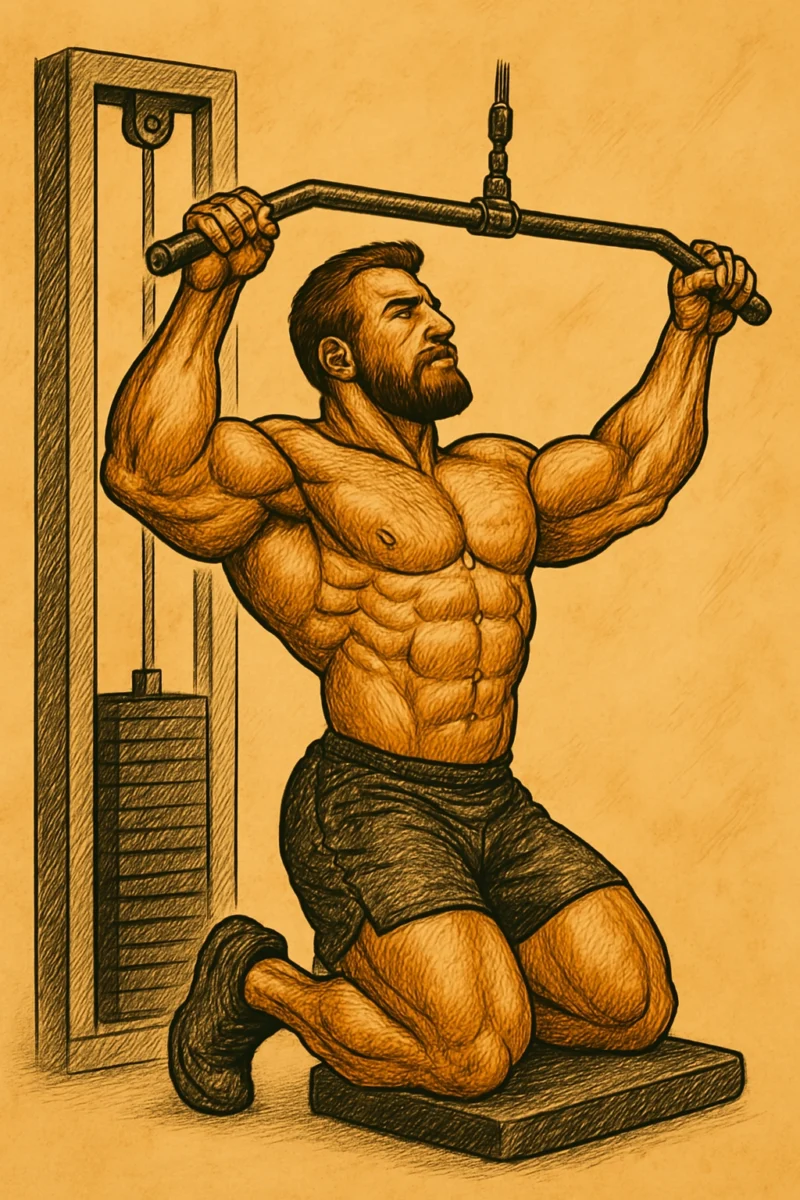
This movement complements other back exercises, such as the bent-over barbell row and dumbbell lat exercises.
You’ll develop a better mind-muscle connection and core stability compared to standard pulldown variations, leading to more effective back development.
Sets and Reps: 3 to 4 sets of 8 to 10 reps
12. Landmine Row
As a unique hybrid between traditional barbell rows and cable exercises, landmine rows deliver an exceptional lat-building stimulus while minimizing the risk of form breakdown.
The exercise’s resistance angle creates a natural arc that’s easier on your lower back than a T-bar row or single-arm dumbbell row.
To perform this press-and-sweep exercise:
- Secure a barbell in a landmine attachment and load your desired weight
- Attach a V-bar handle to the weighted end
- Hinge forward at a 45-degree angle
- Row the weight to your chest, focusing on squeezing your lats and rear delts
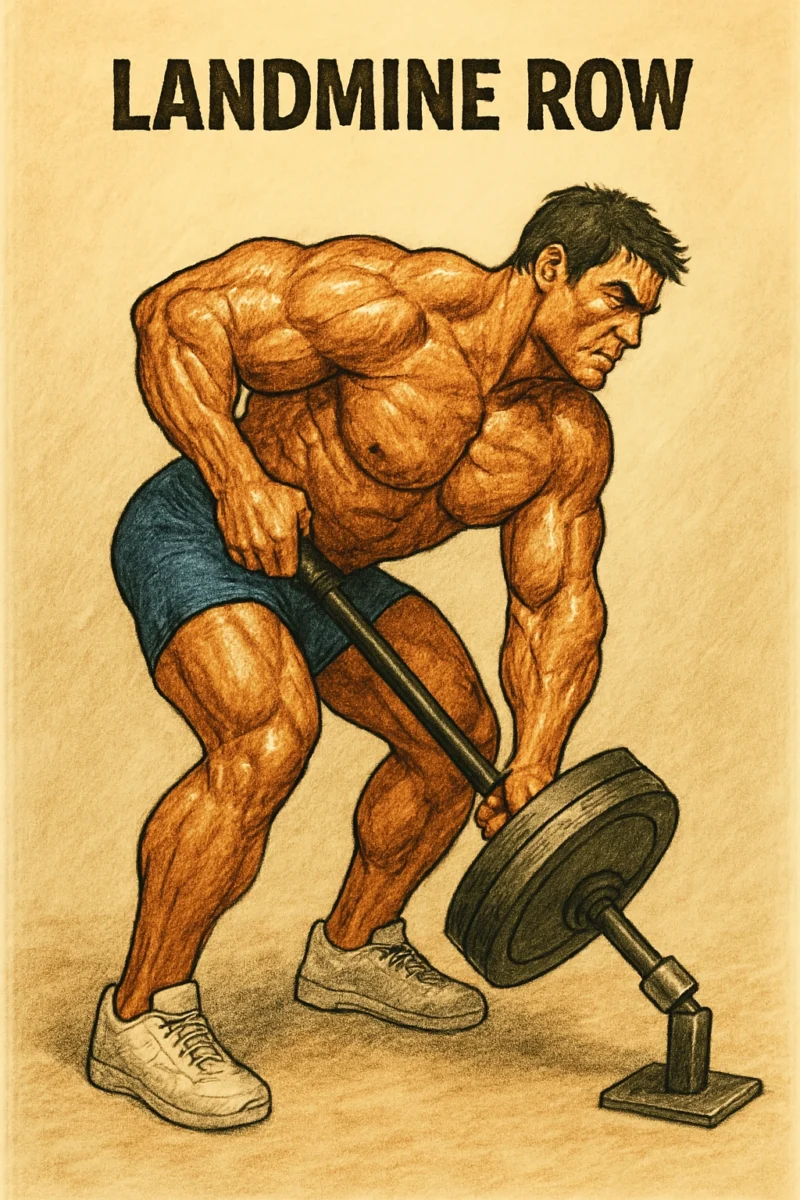
You’ll notice the anchored setup prevents everyday cheating habits, forcing you to maintain strict form throughout each rep.
The fixed path also helps you achieve a stronger mind-muscle connection with your lats.
Sets and Reps: 3 to 4 sets of 6 to 8 reps
13. Dumbbell Pullover
Often considered Arnold’s secret weapon for building his iconic V-taper, dumbbell pullovers deliver a unique stretch and contraction that few other exercises can match.
As one of the most effective lat exercises for building a wider back, it’s a movement that combines chest, core, and back engagement into one fluid motion.
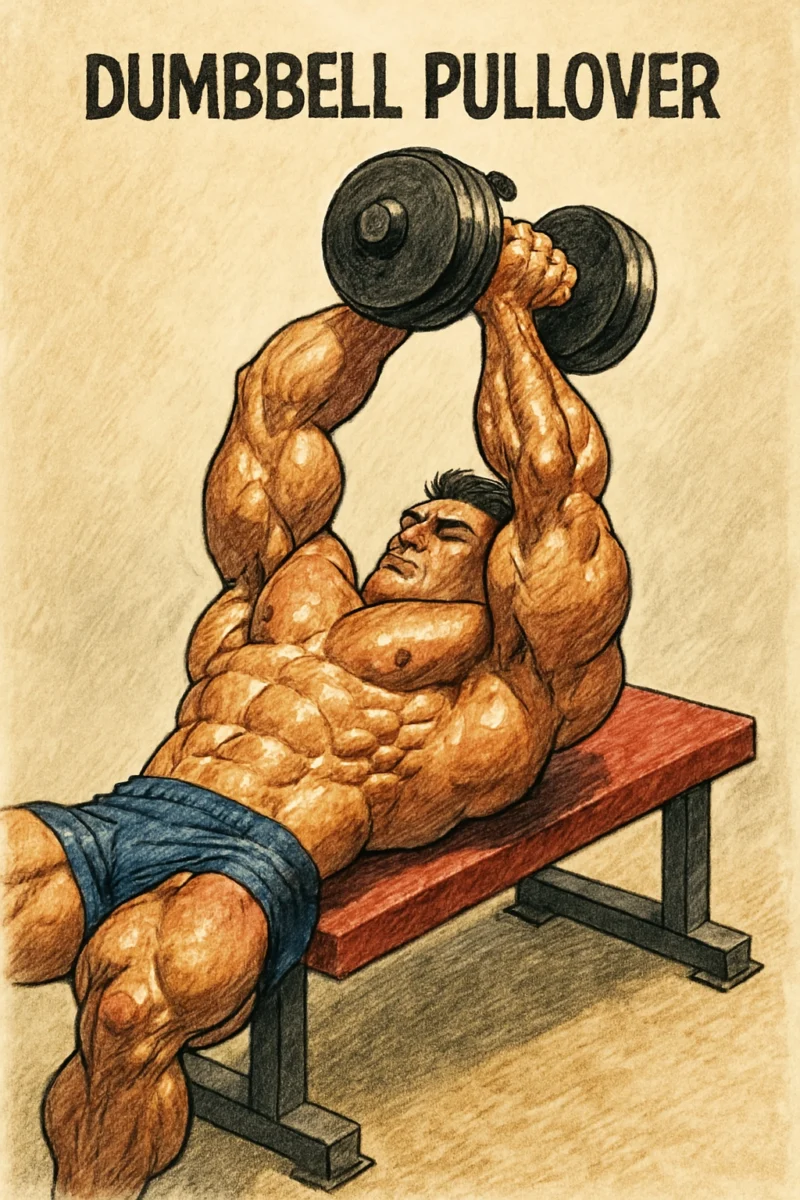
Here’s how to perform this classic exercise:
- Lie back on a bench, gripping a single dumbbell with both hands above your head.
- Lower the weight in an arc behind your head, keeping your arms straight and your torso upright.
- Once you feel the stretch in your lats, pause briefly.
- Drive the weight back up, letting your upper arms follow a row motion.
Aim for 3 sets of 8-10 reps, focusing on controlled movement and maximizing that lat stretch at the bottom position.
Sets and Reps: 3 to 4 sets of 8 to 10 reps
14. Inverted Bodyweight Row
Inverted bodyweight rows pack a serious punch when it comes to building your back, delivering many of the same benefits as traditional barbell rows without needing heavy weights.
This closed-chain movement targets your lats similarly to seal rows and renegade rows, making it a valuable addition to your training routine.
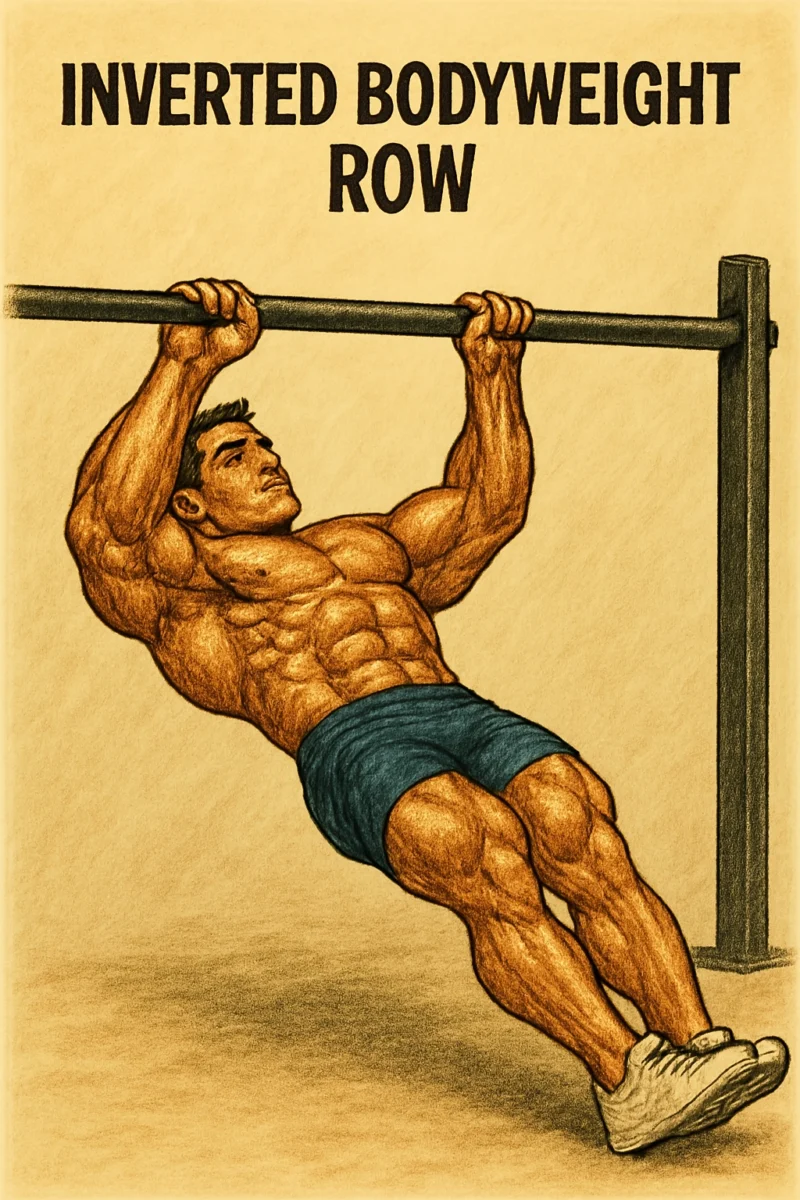
To perform this exercise, position yourself under a Smith machine or bar with an underhand grip slightly wider than shoulder width. Create a 45-degree angle between your body and the ground, maintaining a tight core. Pull your chest toward the bar while squeezing your shoulder blades together, then lower with control.
You can modify the difficulty by adjusting your body angle or bending your knees. The higher the bar, the easier the movement becomes, letting you progress gradually as you build strength.
Sets and Reps: 3 sets of 8 to 10 reps
15. Pendlay/Deadstop Row
The Pendlay row, also known as the deadstop row, offers a powerful variation of the traditional barbell row that’ll help you build serious back strength and muscle.
To perform this move, you’ll position yourself over a barbell with your torso just above parallel to the ground. Keep your core tight throughout the movement, as this protects your lower back and maximizes force transfer.

Unlike the standard barbell row, you’ll reset after each rep by letting the weight come to a complete stop on the floor. This break between reps improves your grip strength and helps maintain proper form for a wider back.
Pull the bar to your lower chest while keeping your elbows at a 45-degree angle. Focus on squeezing your shoulder blades together at the top of each rep.
Sets and Reps: 3 sets of 8 to 10 reps
To Wrap It All Up
You’ve now got the foundational knowledge to build an impressive back through targeted lat training. Whether you’re aiming for Arnold’s iconic V-taper or simply want to improve your functional strength, these exercises will help transform your physique.
Remember, consistency with proper form is key – your lats respond best to controlled movements and progressive overload. Start incorporating these exercises today, and you’ll see noticeable improvements in both strength and width within weeks.
FAQs
What Are the Best Lat Exercises for Beginners?
The best lat exercises for beginners are lat pulldowns, seated cable rows, and assisted pull-ups. These exercises build lat strength and develop proper form for advanced movements. Perform 3 sets of 10-12 reps with controlled movement and focus on squeezing the lats.
How Often Should You Train Your Lats?
Train your lats 2 times per week for balanced growth and recovery. Allow at least 48-72 hours between sessions to optimise muscle repair. Adjust frequency based on training volume, intensity, and overall workout program goals.
What Are Bodyweight Exercises for Lats?
Bodyweight exercises for lats include pull-ups, chin-ups, inverted rows, and Australian pull-ups. These exercises target the latissimus dorsi without equipment, improving back strength and stability. Perform controlled reps to maximise muscle activation.
Pull-Ups vs Lat Pulldowns for Lat Growth
The main difference between pull-ups and lat pulldowns is that pull-ups engage more stabilising muscles, while lat pulldowns isolate the lats effectively. Pull-ups build functional strength and grip, whereas lat pulldowns allow controlled loading for hypertrophy.
Best Lat Exercises for Width
The best lat exercises for width are wide-grip pull-ups, wide-grip lat pulldowns, and straight-arm pulldowns. These exercises target the outer lats to increase back width. Perform 3-4 sets of 8-12 reps focusing on full range of motion.
Lat Workout Routine for Gym Beginners
A beginner lat workout routine includes lat pulldowns, seated cable rows, straight-arm pulldowns, and assisted pull-ups. Perform 3 sets of 10-12 reps per exercise, resting 60-90 seconds between sets to maintain form and maximise results.
Best Lat Workout Program to Buy
The best lat workout programs to buy include Jeff Nippard’s Back Hypertrophy Program, ATHLEAN-X Ultimate Back System, and Built With Science Back Specialization Program. These programs provide structured lat routines with progressive overload and video demonstrations.


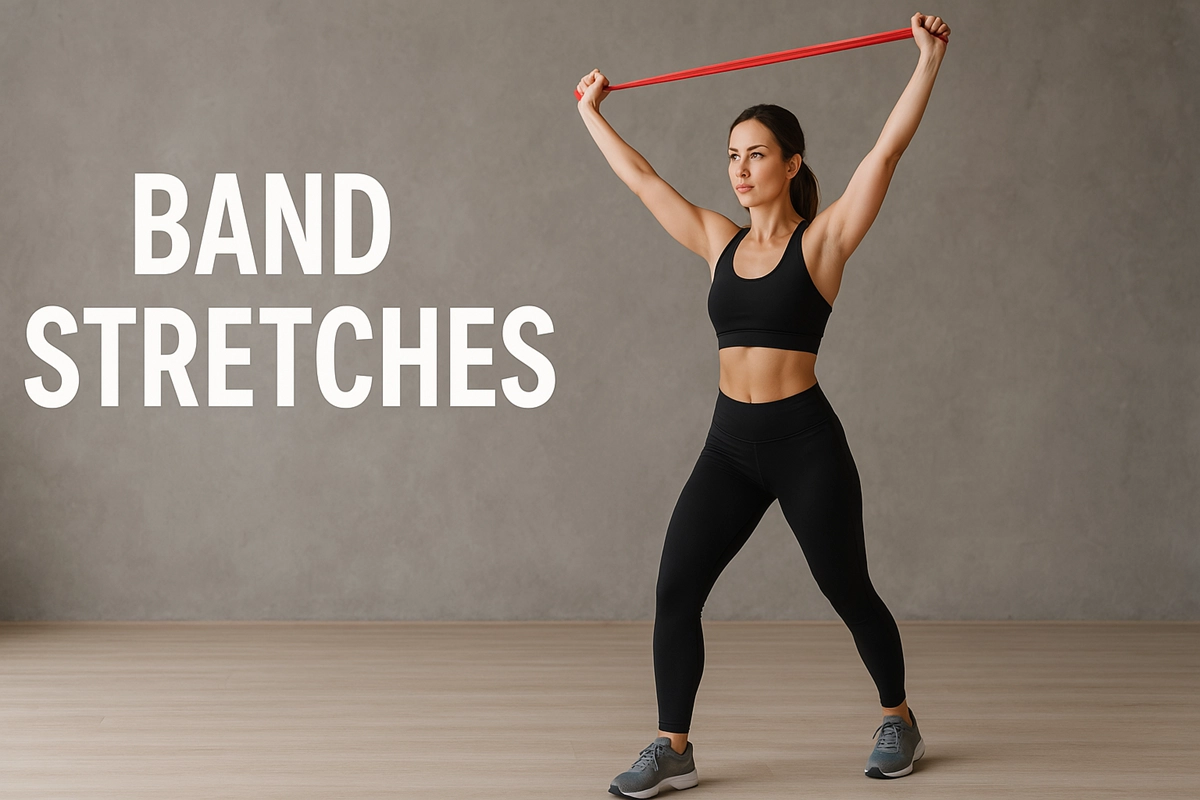
![The Ultimate Home Gym Guide For Women [13 Equipment Only] women home gym equipment guide](https://herculesbodybuilding.com/wp-content/uploads/2025/09/The-Ultimate-Home-Gym-Guide-For-Women-13-Equipment-Only-1200x800.webp)
